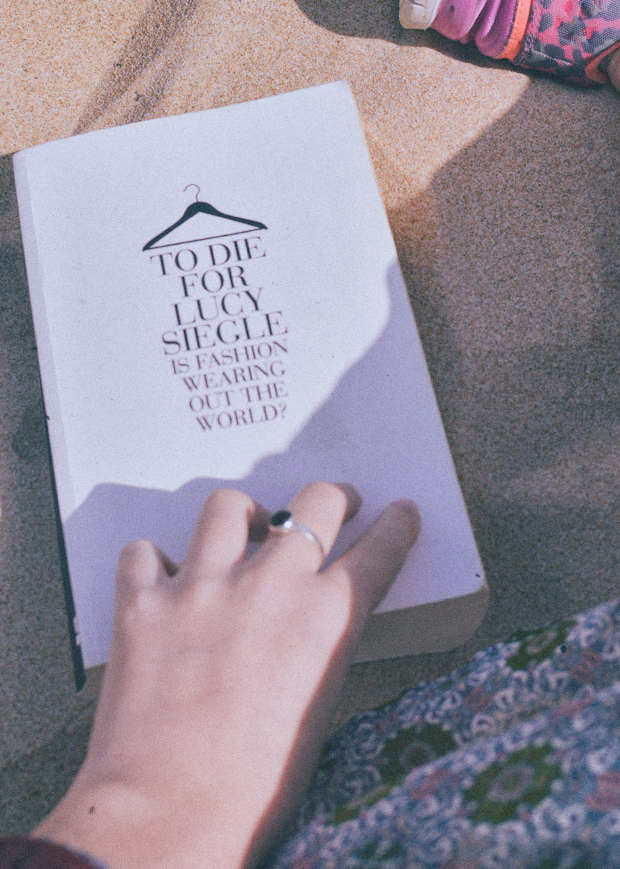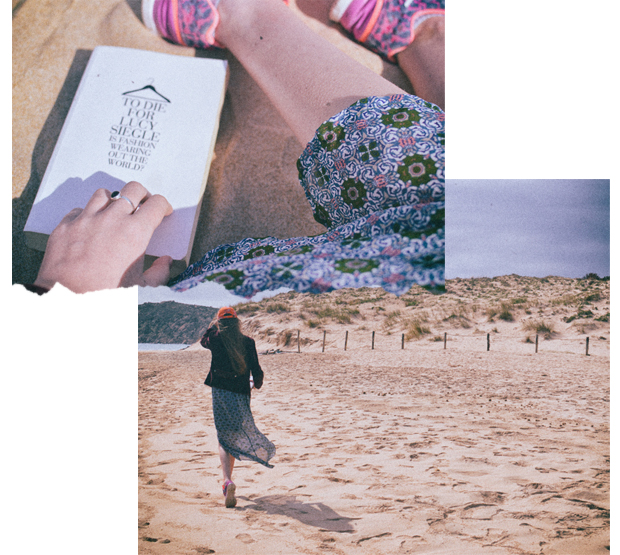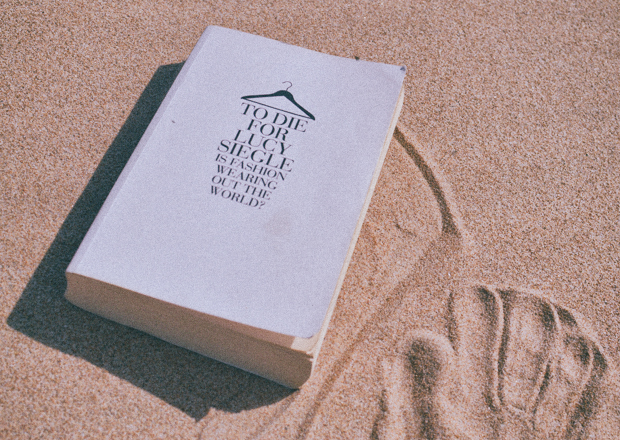Seeing as I’ve mentioned it at least a dozen times in previous blog posts, it’s probably about time I spoke about my reading of To Die For by Lucy Siegle, isn’t it? This book review is going to be in a slightly different format, similar to my review of Vivienne Westwood’s book because I’m going to talk about three different topics I hadn’t thought about before…
If you’re wondering why these pictures were taken at the beach; I read most of this book on a tiny bench by the sea.
#1 – Cotton has a cost…
It’s a lot easier for us all to relate to stories and issues which connect directly with the clothes we wear. It’s easier for us to open our ears and minds to stories about some of the final hands which held them and put the garments together, and it’s even easier for us to forget about the people long before that; the people who made us the fabrics. One of the most eye-opening chapters in To Die For, was the chapter dedicated to cotton and the sections which focused heavily on cotton picking.
One of the biggest cotton producing countries in the world (7th biggest, according to WorldKnowing.com in 2015) is Uzbekistan. I’d never thought about cotton picking in much detail so when I read that “in 2009 between one and two million children were forced out into Uzbekistan’s fields”, it’s safe to say I was taken aback. It’s also safe to say that cotton picking isn’t pleasant labour.

Each year the government-installed system forces millions of Uzbekistani’s to take part in cotton production where they are exposed to unknown chemicals, unsafe and unsanitary housing, and lack of safe drinking water (you can read more about it on CottonCampaign.org); many of these people are children or teenagers.
Lucy interviewed a former cotton-picking student who was supposed to reach a quota of 60kg (132 pounds) per day, for the duration of 54 days. As a sixteen-year-old at the time, she only managed to reach this quota once due to how lightweight cotton is. There is so much more to Gulnara’s story, yet I’d never even thought of it before. When practically all of us wear cotton, why is it that we don’t know enough about it?

#2 – We need to learn more about sustainability…
I’ve always thought more about ethics over sustainability. I suppose not only did I know more about the human side of the industry but it also always struck a chord more easily than say, issues to do with the environment. Knowing that I am responsible for another human being’s treatment to a certain extent was one of the main reason I started approaching fashion more consciously. But I really need to thank this book for making me think about the earth too.
From the date this book was published, the textile industry was one of “the biggest water consumers in the world, using 3.2% of all the 1,400km³ of water available to the human race each year”. This isn’t the only staggering number though, we have to remember that fashion’s footprint is much larger when you consider coal usage, land and water pollution, the effects of herding animals for fibres and skins and all of the added and extra effects which come with the production of things like zips and metal eyelets.
There is so much to consider, it’s no wonder we don’t know enough. There are ways to do it, though. Lucy recommends using a tool called EcoMetrics which enables you to calculate the rough footprint of your wardrobe by looking at what fabrics your clothes are made up of. I’ve yet to try it myself but it’s just one of the small ways you can start to understand sustainability a little clearer.
One of the tools I have used though, is Nike’s Making App which allows you to compare different fabrics and their footprint in different areas. I used it quite a while back in a blog post about my wardrobe at the time but it’s still relevant today too.

#3 – Should we wear fur – faux or real?
Fur is actually a rather hot topic right now. There were PETA protests and campaigns happening at fashion week this season and there are debates and conversations starting up online so perhaps what Lucy spoke about in To Die For will get you looking at it all from a new perspective.
Lucy opens up to the idea that faux fur might also be a contributor to why real, natural fur is an issue within itself. In more recent times, fur has become more of a statement of wealth rather than warmth and practicality that it originated from many moons ago. There’s this illusion that fur is something beautiful and something to hold and treasure because of its cost and value and this idea seems to be coming back into fashion as a very similar statement.
There are pros and cons to each side of the story of faux and real fur but the book made me start to think whether both are equally as bad. Neither option is ethical; chemicals cause faux fur to be polluting and unsustainable and the slaughtering of animals and the treatment of the skins are unsustainable and unethical when it comes to real.
If a faux fur jacket doesn’t degrade for at least six hundred years (according to a quote by Teresa Platt on page 189), how can we really choose either option? It’s come to my conclusion from reading the chapters on both sides of the story, that we really can’t. Wearing faux-fur is still making fur of any kind seem aspirational and iconic. I really want to delve into more surrounding this subject, especially vegan leathers and furs.

Overall, To Die For is definitely one of the heavier books I’ve read on these topics but it’s worth it if you want to focus on areas you have perhaps, a weaker knowledge for. There are also lovely illustrations dotted throughout and unique personal stories which you, of course, won’t find anywhere else.
If you’re looking for a book which is more about ethical brands which are already up and running, I’d recommend taking a look at my review of Slow Fashion by Safia Minney, who is mentioned in this book a couple of times towards the end. For more of a feminist take on things, Threadbare is a great one, and for something just as thought-provoking but a little lighter in terms of writing and size, Stitched Up is another amazing alternative.
I’m currently reading Clothing Poverty, so I’m sure you’ll see a review of that soon.
What do you think of the topics mentioned? Should we wear fur? What books are you reading? Let me know in the comments!








4 Comments
I have second hand faux fur but I do wonder whether the second hand market enables the first hand market (if by donating or selling something people feel less guilty about their normal purchases and therefore buy more first hand items). I’m often apprehensive about wearing the faux fur in case it gives anyone the wrong impression but it is much warmer than any of my other coats. Maybe I should read the book, it’s certainly on my list!
You definitely should when you have the chance! I think it’s something I’m definitely going to think about. I also only have second-hand faux fur… I think mine looks pretty fake/faux so I feel okay with it, but you’re right – maybe it gives people the wrong impression? Food for thought.
I’ve been inkling to read this book. I found your review very insightful and thought provoking. Thank you! I will pock up this book very soon!
Aww I’m glad Michele! Enjoy reading 🙂